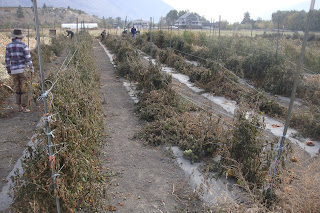 Farming cannot happen without people, and as I have learned this summer, organic farming in particular is substantially more labour intensive than other farming practices. Though we had a rough start at the beginning of the year with many of the young workers leaving the farm, I am happy to report that we finished the season on a high note. For the last two months we had a committed young crew of apprentices, people I can now call my friends, that saw us through the busy season.
Farming cannot happen without people, and as I have learned this summer, organic farming in particular is substantially more labour intensive than other farming practices. Though we had a rough start at the beginning of the year with many of the young workers leaving the farm, I am happy to report that we finished the season on a high note. For the last two months we had a committed young crew of apprentices, people I can now call my friends, that saw us through the busy season.Though we are all different ages, come from different places, have very different educations, and have divergent world views there seems to be something about what has brought us to Klippers Organics that automatically unites us. We all love food, love being outdoors, don't have a huge affinity towards material possesions, and are trying to find our place. As our departure date nears, questions about what we will do next in life are constantly at the forefront. Though it is often uncomfortable not to know, it has been reassuring to know that I am not alone in my uncertainty about the world and my place in it. What I do know is that your actions are concrete and your values, though ever changing, are with you wherever you go. The people here have taught me to keep taking life one day at a time, not to worry about the outcome of events until it is upon you and to enjoy every experience for what it is while it lasts. I hope that the laughs we have laughed, the jokes we have made, the stories we have shared and the comraderie we have built while we have grown and cooked food together is evidence that we are following our own advice.
Thank you for the good times, the laughter, the learning and above all the memories. Good luck in your futures everyone!
Some memories I will not forget...
....Manon stuffing unusual items into her clothing including eggs, every kind of food and a dead bird!
....Oliver conducting to the plants, dancing in the fields and always having an inside joke.
....Kirsten producing some fabulous mead, beer and other fermentation projects.
....Gina exposing me to more beautiful music and 'probably, maybe' her indecisive language.
....Mark eating honey, nut butter and bread exclusively for every meal.
....Kerry dressing up as the most fabulous dancing bear for Halloween and getting her party on in Cawston.
....Whitney making corny jokes.
....and Nadja gossiping with me when no one else would (and her beautiful eyes).













 Tomatoes! Death becomes you. The tomatoes are dead. The frost earlier this week did them in, and we are happy. A couple of people here still tried to salvage a few last tomatoes to extend the tomatoe sandwhich addictions they have developed over the last few weeks. And others yet were trying to nab a few for seed saving purposes. But for the most part, we are done with them. (Side note - to save tomato seeds you crush the seeds out of the flesh of the tomato, cover these vegetable innards and let them ferment which deactivates the compounds that would allow the seeds to sprout. So when you actually collect the seeds, you are getting them out of a goopy, foul smelling, fermented mess you have let sit for weeks.)
Tomatoes! Death becomes you. The tomatoes are dead. The frost earlier this week did them in, and we are happy. A couple of people here still tried to salvage a few last tomatoes to extend the tomatoe sandwhich addictions they have developed over the last few weeks. And others yet were trying to nab a few for seed saving purposes. But for the most part, we are done with them. (Side note - to save tomato seeds you crush the seeds out of the flesh of the tomato, cover these vegetable innards and let them ferment which deactivates the compounds that would allow the seeds to sprout. So when you actually collect the seeds, you are getting them out of a goopy, foul smelling, fermented mess you have let sit for weeks.)















 Rotting walla wall onions that had to be discarded.
Rotting walla wall onions that had to be discarded.


 Cleaning onions that have been curing in the field for storage.
Cleaning onions that have been curing in the field for storage.




